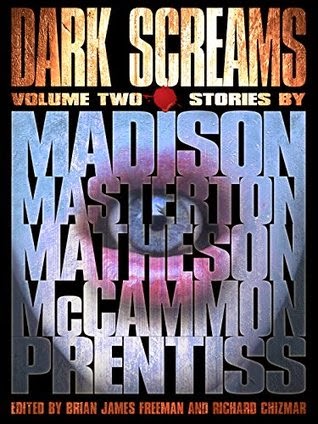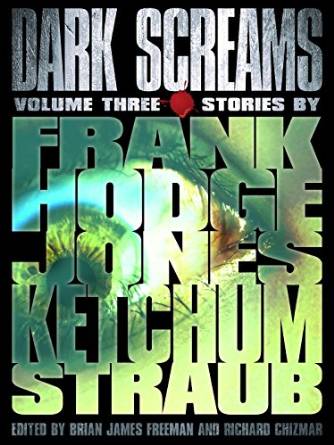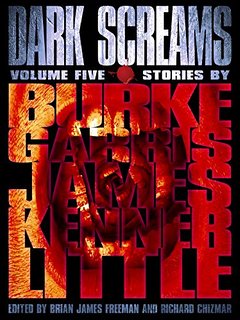Dark Screams Vol. 1 – Richard Chizmar, Brian James Freeman (Ed.)
“You can’t predict what a man will do in a given situation after he reaches a certain degree of dumbness, because the man himself doesn’t know if he’s going to s–t or put his fingers in the fan.”
-Stephen King, ‘Weeds’
Consisting of 5 stories from highly regarded authors, volume 1 of Dark Screams exhibits a unity generally not found outside of themed anthologies.
Stephen King opens the book with his tale “Weeds,” where a less than intelligent man finds a meteor and inadvertently touches it. He then finds a strange, rapidly expanding growth on his fingers the next morning and begins to panic as the moss-like growth spreads.
Kelly Armstrong ups the ante with her following tale “The Price You Pay,” where the lives of two young girls are played out in non-linear fashion as we flash between past and present to discover why they are chained separately in a dark basement and receiving beatings from a strange man.
Bill Pronzini’s “Magic Eyes” takes a slight step back as we follow a man in an asylum, frequently writing in his diary that he doesn’t trust his doctor, he’s innocent of his crime, and he actually saved his wife from being devoured by a monster with particularly striking eyes.
Simon Clark spins the best tale here with his “Murder in Chains,” about a man who wakes in an unknown subterranean passage chained by the neck to a physically unstoppable madman. Of all 5 tales here, this one lashes the reader to the character(s) the quickest and screams toward a somewhat baffling conclusion while still remaining effective.
Ramsey Campbell closes the book out with “The Watched,” which is a fair story but perhaps the weakest of the collection, about a boy who begins spying on the drug-dealing neighbors next door for a disgraced ex-policeman who’d seen his daughter fall to drugs and wants revenge.
These are solid, mostly fast paced horror stories. King is, of course, The Man, and nearly every story he writes is good. It was nice to see Armstrong follow him up so strongly. Mr. Pronzini’s tale is also very enjoyable. The biggest surprise was the upset of Simon Clark and his extremely effective ‘man at the end of his rope’ (chain). Mr. Campbell has written some of the best, most riveting stories in print and also some of the slowest and least effective. His tale here was one of the slower ones but keeps with his popular style and should be quite enjoyable to fans.
Having appeared out of the blue, Dark Screams Vol. 1 was short but extremely enjoyable and shows great promise for the upcoming releases in the new series.
4 stars

Dark Screams Vol. 2 – Richard Chizmar, Brian James Freeman (Ed.)
Consisting of 5 short stories, Volume 2 contains works from Robert McCammon, Norman Prentiss, Shawntelle Madison, Graham Masterson and Richard Christian Matheson.
The collection starts strong with “The Deep End,” McCammon’s tale of a swimming pool that has a rising body count and a father’s determination to find out what’s happening and bring about justice.
Mr. Prentiss follows up with “Interval,” a tale of an airline disaster and an entity wrapped up in the deaths of numerous people preying on the survivors.
Shawntelle Madison isn’t quite as well known, but has a strong entry here in “If These Walls Could Talk,” involving the pre-production of a film shoot in a house with a dark history, where the mystery needs to be solved before the cast and crew show up in a few days and photography begins.
Graham Masterson takes the prize here for the top story with his “The Night Hider,” as we not only get some history of the beloved C.S. Lewis, but we also get to know exactly how he received his inspiration as a haunted wardrobe terrorizes its new owner.
Finally we have Richard Christian Matheson’s, “Whatever,” which is misfiring on all cylinders. This guy writes some outstanding short stories in general, but this one is tough. The story is a series of notes, articles and lyrics following a band around, and perhaps music aficionados can find more to like in this one, but it’s much harder to enjoy than his other work.
Dark Screams volume 2 is overall an enjoyable read, has an excellent Masterson story and the others hold their own while newcomer Mrs. Madison comes out swinging in a big way. The only real disappointment was R.C. Matheson’s tale.
When volume 3 is released it’s probably best to drop everything and read it based on the strengths and surprises of the first two books.
3 stars

Dark Screams Vol. 3 – Richard Chizmar, Brian James Freeman (Ed.)
Consisting of 5 short stories, this book contains works from Peter Straub, Jack Ketchum, Darynda Jones, Jacquelyn Frank and closes with the longest of the bunch by Brian Hodge.
Peter Straub opens with “The Collected Short Stories of Freddie Prothero,” about the greatest writer the world has ever seen, dead at age nine. His stories have been collected into this book posthumously for scholars to pore over and also in order to show his progression as a writer beginning at age six. It’s easy to stick with this one most of the way through and think it’s really going somewhere very special, but in the end seems difficult to put the pieces together properly. A comparison to Flowers for Algernon can be made, but that doesn’t explain the disconnect.
“Group of Thirty” by Jack Ketchum takes a huge step up as a middle-aged writer accepts an invitation to be a guest speaker for a group of 30 excited SF fans in a nearby town. More explanation could hurt the read, and this could be the best story in the book.
“Nancy” by Darynda Jones is the story of a new girl, frequently moved around by her father and no stranger to new schools, adjusting to the town of Renfield, the most haunted town in America. She recognizes and is initially accepted by the popular click of girls but finds a soft spot for another girl at the school, an outcast who claims to be constantly haunted by the spirit of a deceased boy. This is another very well written story.
“I Love You, Charlie Pearson,” by Jacquelyn Frank, is the story of a high school stalker pursuing his prey. He’s not trying to hurt her, but he loves her so much he can’t stand it and comes up with a plan to get her alone in his house. A damned good story, expertly told, even if the theme can feel a bit worn by the end.
“The Lone One and Level Sands Stretch Far Away” by Brian Hodge, a good deal longer than most of the stories here, is a captivating tale of a man and his wife and their new next door neighbor. The neighbor’s a fitness fanatic, and eventually the husband begins running with her, graduating to parkour activities and eventually urban exploration. His wife becomes increasingly jealous of the relationship between the two but eventually joins them in a series of ill-fated expeditions to an abandoned brewery. This final one was the most gripping of all and was difficult to set aside but doesn’t quite maintain its mastery through to the end. Still, that’s not much of a fault when assessing the story as a whole, and this remains one of the best in the series.
Volume 3 was the best of the Dark Screams volumes yet.
4 stars

Dark Screams Vol. 4 – Richard Chizmar, Brian James Freeman (Ed.)
“If she could have plunged back into life to change one thing she would have left the broken romances in pieces and gone to her six-year-old son, Finn, to say: Trust your dreams, and take the world lightly, for it means nothing, even in the losing.”
-Clive Barker
“The Departed” – Barker tells an excellent story about a man and a woman who have passed into the afterlife and are lingering around the woman’s son. Her estranged husband has returned to claim the boy and as Halloween approaches the mother and her friend, although invisible, don clothing to make themselves seen so she can interact with her son one more time.
“The New War” – This one ranks slightly better than the excellent Barker tale, written by Lisa Morton about an elderly man recovering from hip surgery while hospital bound with a mind that’s playing tricks on him. A mysterious black thing is sometimes seen sitting on the chests of other patients at the hospital, and by the next morning another death has occurred. The man tries recruiting help dealing with the black thing but his own mental struggles only complicate this new fight.
“Sammy Comes Home” – Ray Garton ups the ante in a collection that started strong and keeps getting stronger. Jeremy is the father of the quiet, introspective 8-year-old Bryan, whose dog ran away about a week earlier. Other pets from the neighborhood that have been disappearing lately as well. The family has company when a scream is heard from the front porch by the visiting Monica, and Sammy’s back. But he’s hurt badly and a trip is thrown together to get him to the vet asap, only to discover there’s a very real danger in town. This one’s got a wonderful ending.
“The Brasher Girl” – By far the longest story of the book, Ed Gorman whips up serious tension by lashing us to a main character who’s still dealing with the emotional baggage of being discarded by the love of his life. A 23-year-old soldier is adapting to civilian life and has returned to his home town where he meets and pursues the gorgeous 17-year-old Cindy. But Cindy’s got a boyfriend, and a ‘secret’ friend, and our hero has to deal with them both while living down a traumatic separation he suffered when he was 17. This is solid, troubling storytelling.
“Creature Feature” – Closing out the book is Heather Graham’s horror-house story where a special effects crew has prepared all manner of monsters for display, including Jack the Ripper. When a friend stops by to see the display the night before the show is to open her instincts tell her something is not quite right.
For a quick recap of the series so far, we had a very strong start with Volume 1, and while Volume 2 was still good it took a step back. Volume 3 was the best when it was released, showcasing a smooth storytelling that had nearly every story flowing like silk. Then Volume 4, every bit the masterful volume that Volume 3 was.
There’s fast, smart horror here, and it flows much like Volume 3 did. The top slot goes to Ray Garton, partly because of his all too human ending, but he barely edges out Lisa Morton and Ed Gorman, who barely edge out the inestimable Barker. This is where it’s at, and if you’re only going to check out one of these books, or haven’t yet read any, this one is an excellent choice.
4 stars

Dark Screams Vol. 5 – Richard Chizmar, Brian James Freeman (Ed.)
“The rude truth I discovered is that Hollywood hates horror, doesn’t understand it, is embarrassed by it, but likes to tell you how it’s done.”
-Mick Garris
“Everything You Always Wanted” by Mick Garris is the longest story by far, taking up a bit more than half the book, and tells the tale of a semi-successful middle-aged filmmaker. He has a particularly effective film under his belt as a young man but is now well over the hill and attending a fan convention in Indianapolis. He meets a mysterious, attractive woman and has the best sex of his life but is left to deal with terrifying after effects. Solid horror.
“The Land of Sunshine” by Kealan Patrick Burke was the most cerebral tale here, feeling a bit like vintage Ramsay Campbell. Consumed by the guilt of his infidelity a man turns inward while his life takes on surreal aspects as he attempts to reconcile. This one carries a poetic, strong but defeated writing style: “Exhausted, he slipped out of his wet shoes and carefully lowered himself down onto the bed, where he sat for some indeterminate amount of time, long enough to see the sun not rise and the sky not lighten from anything other than permanent dark.” Powerful, somber stuff.
Ratcheting the energy back up, “Mechanical Gratitude” by Del James is a knockout. Memories contained in a classic ’68 Camaro are picked over as we learn how lovingly the car was treated and how often the backseat was used by the amorous owner and his wife, still together 40 years later. The tale spins darker as the wife receives a call from the hospital and drives off in the Camaro, reminiscing along the way. Superb ending here to a superb story, with a few lessons for us as well. This is the greatest story from any of the 5 Dark Screams volumes–read it if you get a chance.
“The One and Only” by J. Kenner features a college man with a recently broken heart on a bender with friends in New Orleans to get over it. They run into Marie Laveau’s granddaughter, mixing a broken heart, voodoo and booze, and this one’s another great story.
“The Playhouse” by Bentley Little was bizarre and effective, as a realtor attempting to sell a house has an experience in a playhouse in the back yard that is beyond her ability to understand. When it happens a second time her world is upended, and while there’s little resolution here it was with a certain glee you begin to understand what’s going on. It’s a great story and a fitting end to the series of books.
4 stars
As a whole, considering all 5 books as part of a larger unit, this is as varied an anthology as anyone is producing these days but is well paced so there aren’t sections that bog down under the weight of language for the sake of language. Like a mixtape from yesterday each story has it’s place and seems prominently featured, perhaps a by-product of splitting it up into 5 volumes. The authors are quite varied, everyone gets a chance, and it’s some of the less well known names really putting the smack down. Del James, Ray Garton and Jack Ketchum contributed phenomenal work, but everyone here has something to say and it’s a beautiful thing they’re given the opportunity to do so. Mr. Chizmar and Mr. Freeman have shepherded in a collection worthy of the contributing talent, and worthy of Cemetery Dance.
Volumes 1-5 averaged: 4 stars


Always happy to hear from book lovers. Please feel free to comment!